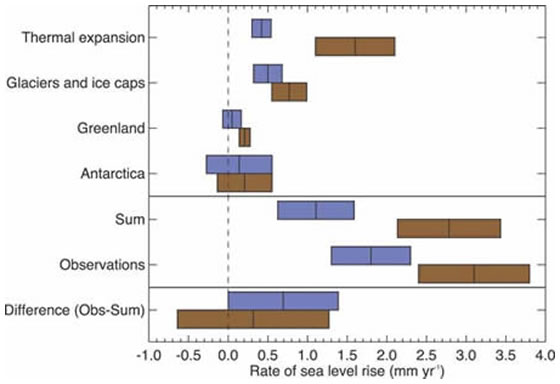Monitoring the ocean state: heat and freshwater content, and global sea level
The fact that Argo provides temperature and salinity information from the upper 2km of almost all areas of the global ocean has made it possible, for the first time, to monitor the global ocean state. This includes the detection of temperature and salinity change and the possibility of attributing the patterns of change to anthropogenic influences (King and McDonagh 2005; Stark et al. 2006). There are numerous publications relating to the ability of Argo data to document year-to-year changes in the properties of mode waters (water masses modified by energetic wintertime exchanges of heat and fresh water with the atmosphere). Our understanding of the processes involved and the significance of changes will be greatly enhanced as the length of the Argo record is extended.

Estimates of the various contributions to the budget of the global mean sea level change (upper four entries), the sum of these contributions and the observed rate of rise (middle two), and the observed rate minus the sum of contributions (lower), all for 1961 to 2003 (blue) and 1993 to 2003 (brown). The bars represent the 90% error range. For the sum, the error has been calculated as the square root of the sum of squared errors of the contributions. Likewise the errors of the sum and the observed rate have been combined to obtain the error for the difference. Reproduced from IPCC AR4 (Bindoff et al., 2007).
The 2007 IPCC report provided a breakdown of the contributions to sea level made by the main factors involved (See above). Thermal expansion of the ocean water column is a major contributor and one that, thanks to the combination of Argo and satellite radar altimetry, it is now possible to quantify with some accuracy (Domingues et al., 2008; Church et al. 2008; Wijffels et al. 2008). As the Argo record is extended and the accuracy of its data improves it will be possible to better quantify the other contributions to sea level variations especially those due to changes in air-sea fluxes (atmospheric aerosols from volcanic activity, changes in cloudiness).